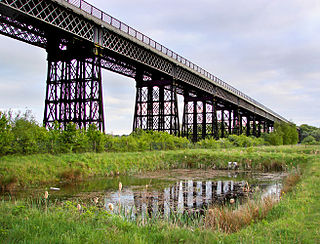
Bennerley Viaduct is a former railway bridge, now a foot and cycle bridge, between Ilkeston, Derbyshire, and Awsworth, Nottinghamshire, in central England. It was completed in 1877 and carried the Great Northern Railway's (GNR) Derbyshire Extension over the River Erewash, which forms the county boundary, and its wide, flat valley. The engineer was Samuel Abbott, who worked under Richard Johnson, the GNR's chief engineer. The site required a bespoke design as the ground would not support a traditional masonry viaduct due to extensive coal mining. The viaduct consists of 16 spans of wrought iron, lattice truss girders, carried on 15 wrought iron piers which are not fixed to the ground but are supported by brick and ashlar bases. The viaduct is 60 feet high, 26 feet wide between the parapets, and over a quarter of a mile long. It was once part of a chain of bridges and embankments carrying the railway for around two miles across the valley but most of its supporting structures were demolished when the line closed in 1968. The only similar surviving bridge in the United Kingdom is Meldon Viaduct in Devon.

Corby Bridge is a railway viaduct adjacent to and immediately east of Wetheral railway station at Wetheral, near Carlisle, in north-western England, begun in 1830 and completed in 1834. It is 920 feet (280 m) long and 100 feet (30 m) high, and has been a Grade I listed building since 1 April 1957.
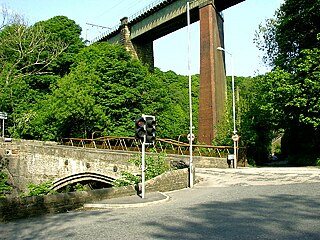
Broadbottom Viaduct is a railway viaduct that spans the River Etherow between Derbyshire and Greater Manchester in England. Originally of wooden construction supported by stone piers, the timber was replaced first with wrought iron box girders, less than 20 years after the viaduct's opening, later followed by steel trusses and more supporting piers.
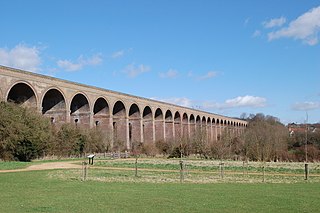
The Chappel Viaduct is a railway viaduct that crosses the River Colne in the Colne Valley in Essex, England. It carries the Gainsborough Line which now is a short branch linking Marks Tey in Essex to Sudbury in Suffolk. The line previously, however, extended to Shelford in Cambridgeshire.
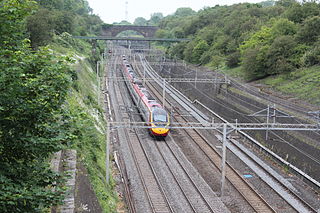
Roade Cutting, also known as Blisworth Cutting, is a railway earthwork and 15.2-hectare (38-acre) geological Site of Special Scientific Interest along the West Coast Main Line north from Roade in Northamptonshire, England. It is a Geological Conservation Review site.
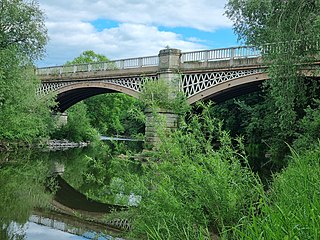
Belvidere Bridge is a cast iron arch railway bridge in Shrewsbury, western England, built for the Shrewsbury and Birmingham Railway in 1849. It carries the modern Wolverhampton to Shrewsbury railway line over the River Severn and is a grade II* listed building.

Brandon Viaduct is a railway viaduct crossing the River Avon between the villages of Brandon and Wolston in Warwickshire. It carries the Birmingham Loop line and is roughly half way between Rugby and Coventry. The bridge was built in around 1835 for the London and Birmingham Railway and is now a grade II listed building.

The Sowe Viaduct is a railway bridge on the Birmingham Loop line crossing the River Sowe at the south-eastern edge of Coventry in central England. Built in 1838, it is a Grade II listed building.

The Sherbourne Viaduct is a railway bridge that carries the Birmingham Loop line across the River Sherbourne in Coventry, central England. Built in 1838, it is a grade II listed building.

Mile Lane Bridge is a road-over-rail bridge in Coventry, central England. It is possibly the first use of a flying arch over a railway cutting and is a Grade II listed building.

Wolverton Viaduct is a railway bridge carrying the West Coast Main Line over the River Great Ouse to the north of Wolverton, part of Milton Keynes, in south-eastern England. Built in 1838 for the London and Birmingham Railway (L&BR) to the design of Robert Stephenson, it was the largest viaduct on the L&BR's route. It is in the centre of Wolverton Embankment, itself the largest on the line. It has six brick arches and covers a distance of 660 feet, reaching a maximum height of 57 feet above the river, and terminating in substantial abutments which contain decorative arches. The viaduct and embankment feature in drawings by John Cooke Bourne. Several contemporary commentators likened Stephenson's bridges to Roman aqueducts. Some modern engineers and railway historians have suggested that Wolverton Viaduct is not as innovative or impressive as some that followed but nonetheless praised its visual impact.

The Blisworth Arch is a railway bridge in Blisworth, Northamptonshire, in eastern England. It was designed by Robert Stephenson for the London and Birmingham Railway and completed in 1837. It is a grade II listed building and a significant local landmark.

Hampton in Arden packhorse bridge crosses the River Blythe near Hampton in Arden in the West Midlands of England, between Birmingham and Coventry. Dating from the 15th century, it is the only bridge of its kind in the area now covered by the West Midlands, and is a grade II* listed building and a scheduled monument.

The Brent Viaduct is a railway bridge carrying the West Coast Main Line over the valley of the River Brent just south of Stonebridge Park station in north-west London, England. Originally built in 1838 for the London and Birmingham Railway, it is now a Grade II listed building.

The Colne Viaduct, also known as Five Arches Viaduct, carries the West Coast Main Line railway over the River Colne near Watford in Hertfordshire, Eastern England, just north-west of London. It was built in 1837 for the London and Birmingham Railway by Robert Stephenson.

Abbots Langley railway bridge, also known as the bridge over Railway Terrace is a skew bridge carrying the West Coast Main Line over a road near Abbots Langley, Hertfordshire, in Eastern England. The angle of the bridge creates a 25-metre (82-foot) tunnel along the road. It was built in 1837 and is a Grade II listed building.

Nash Mills railway bridge carries the West Coast Main Line railway over the Grand Union Canal to the west of Nash Mills, Hemel Hempstead in Hertfordshire, Eastern England. The bridge was built to the designs of Robert Stephenson for the London and Birmingham Railway and completed in 1837. Although modified, it is still in use and is Grade II listed building.

Old Wolverton Road Bridge carries the West Coast Main Line over Old Wolverton Road just north of Wolverton Works in Buckinghamshire, southern England. It was designed by Robert Stephenson for the London and Birmingham Railway and opened with the line in 1838. It is a Grade II listed building.
Blue Bridge was built in the 1830s to span the London and Birmingham Railway (L&BR) but now spans an empty cutting near Wolverton Works in Buckinghamshire, southern England. It was designed by Robert Stephenson, the L&BR's chief engineer and extended in the 1880s when the line was widened. It is a Grade II listed building.

Weedon Viaduct is a railway bridge carrying the West Coast Main Line through Weedon Bec in Northamptonshire, England. It was designed by Robert Stephenson for the London and Birmingham Railway and opened in 1838. It is a Grade II listed building.




















